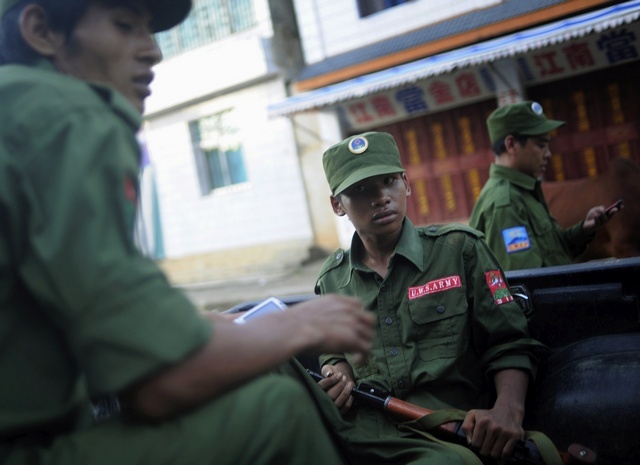China has carried out its first transfer of armoured vehicles to the United Wa State Army (UWSA), in what may be a bid by Beijing to use the powerful group as a source of leverage in Burma as the government there develops stronger ties with the US.
The transfer of Chinese-made PTL02 Wheeled Tank Destroyers is believed to have taken place in the middle of last year, according to Janes Intelligence Review. The author of the report, Thailand-based intelligence analyst Anthony Davis, says that the delivery marks “a significant escalation in the equipment supply to the UWSA” from China.
The information was passed on from several well-informed sources close to the Wa, which at 30,000 troops is Burma’s largest and best-equipped ethnic army. They control several pockets of territory in Shan state, with the majority of their forces based along the border with China.
The resupply effort “has been unprecedented both in the quantity of munitions and the type of systems delivered, and is highly likely to have stemmed from a high-level decision made in Beijing,” the report says. The timing of the transfer of the armoured vehicles, which was reportedly accompanied by Chinese-made man-portable air-defense systems (MANPADS), is likely closely connected to recent political developments in Burma.
“The Chinese are clearly concerned over rapid US diplomatic and military overtures to the Burmese government,” Davis told DVB. “By facilitating the reinforcement of the Wa they’re sending a very clear message to the Tatmadaw [Burmese army] that there are limits to their patience.”
Relations between Burma and its longtime ally and patriarch soured in late 2011 when Naypyidaw cancelled the $US3.6 billion Myitsone dam project largely financed by Beijing. The decision was thought to have stemmed from a growing frustration within Burmese political and military circles about the country’s reliance on China.
“[China is] not prepared to put up with a whole string of Myitsone dam situations that could result in the cancellation of major projects and a loss of years of investments,” said Davis. “The markers they’re using [to signal this] are very clear and subtle: they’re not supplying a group that is at war with the government, but are supporting a deterrent – the Wa are in an umbilical relationship with China, and supporting the Wa effectively reinforces the status quo and stability along the border.”
The same cannot be said for China’s more mercurial relationship with the Kachin Independence Army (KIA) in northern Burma, which remains locked in a fierce battle with the government. The KIA’s headquarters in Laiza sit directly on the border with China, and on several occasions in the past month, shells fired at Laiza have landed on Chinese soil.
China has prepared refugee camps for those fleeing across the border, and according to Kachin sources, Burma used Chinese airspace for bombing raids on KIA positions. But China’s position on the conflict has been somewhat ambivalent – it sharply criticized the shelling, and allowed Kachin living in China to march up to the border to protest the airstrikes.
“China has too much at stake in Burma to afford to antagonise the Burmese government, so they are playing both sides, hoping things will work out alright for China in the end,” says Bertil Lintner, a longtime Burma analyst. “No war, no refugees, but plenty of business.”
The prospect of the Wa engaging in conflict with the Burmese government is slim, says Lintner. The group has kept to a ceasefire with the government, which some believe has carried dividends that include tacit allowance by the government for the Wa to manufacture narcotics in its various enclaves in Shan state. “The stuff they [China] have given the Wa is … to scare the Burmese government and make sure they don’t attack the UWSA as well,” he said.
The closest the UWSA has recently come to a conflagration was in August 2009, when the Burmese army attacked the Kokang militia group in northern Shan state. Like the UWSA, the Kokang formed from the ashes of the Burma Communist Party (BCP), which collapsed in 1989. Both the UWSA and China, which had supplied arms to the BCP and whose Red Guard troops fought with the BCP, were angered at the Kokang assault.
Since then the UWSA is believed to have supplied small arms to the Kachin. “They’ve given them things like bullet cartridges and small weapons,” said Aung Kyaw Zaw, a China-based military analyst. “It started after the Kokang collapse, to support the armed revolution. The UWSA has also supplied other groups.”
He added that the UWSA also had armoured personnel carriers (APCs) that were supplied by Ukraine, with China thought to have allowed passage through its territory for transport of the vehicles. This has not been independently confirmed.
The Burmese army’s experience in Kachin state would no doubt caution against any conflict with the UWSA. The KIA is far weaker in manpower and weaponry than the Wa army, which Janes says is “one of the world’s largest and best-equipped non-state armed groups”.
Its relations with China are crucial to this. Davis writes in the Janes report that the UWSA’s more recent procurements of heavy weaponry were “acquired on China’s ‘grey’ arms market, a zone of plausible deniability peopled largely by ‘private sector’ middle men, usually with backgrounds in China’s military and intelligence services and with close links to state-owned arms manufacturers.”
He says however that transfers of arms as sophisticated as MANPADS “could not take place without explicit sanction from senior levels of China’s national security establishment”.



